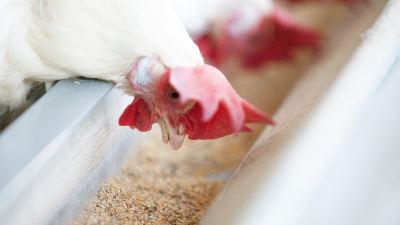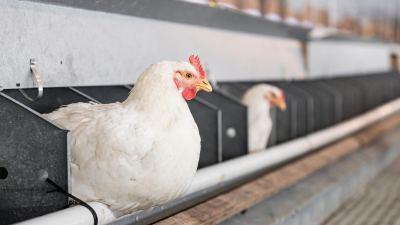Pat Crowley: Mitigating mycotoxins economically

Mycotoxin management should be on every feed producer and farmer's radar.
Mycotoxin contamination can affect even the most well-run dairy farms. Pat Crowley, on-farm specialist at Alltech, details how farmers can reduce the cost of production on their dairy farms by detecting mycotoxins early.
The following is an edited transcript of Tom Martin’s interview with Patrick Crowley. Click below to hear the full audio.
Tom: Patrick Crowley is an on-farm specialist at Alltech based in the dairy capital of the USA, Wisconsin. He has over 23 years of experience in the dairy industry and is known to be the silage expert on the team. He works with dairy producers, nutritionists and consultants, troubleshooting a range of issues on farms in the Midwest. Among those issues is the management of mycotoxins. He joins us to provide an update on efforts to mitigate the risk of mycotoxins without breaking the bank. Thanks for being here, Patrick.
Pat: Thank you for having me.
Tom: So, if you would, bring us up-to-date on the mycotoxin issue. What are you seeing as you work with producers?
Pat: This year, when I look back and see what we're looking at and finding on dairies this year, I’ve really got to go back to last fall. Last fall, we had a tremendous amount of rain. We're predicting it was the wettest fall in over 100-plus years that we have had, so we go back there and we identified this risk and the weather challenge. What we did, we brought it to the dairy harvest analysis, a North American Harvest Analysis. What that is, is we randomly checked corn silages out on the dairy, just spot-checking them. We did about over 100 to 150 different samples, and what we're looking at is what mycotoxins were coming off the field before fermentation, before storage, before feed-out, so we really understood what was out there. When I look back to the average sample, if you take all the samples' average amount, it was 6.25 mycotoxins per sample, and that's fresh out of the field. The main mycotoxins that we were seeing were the type B trichothecenes, the DONs, or some people would call the vomitoxins, the fusaric acid and the fumonisins. They're really, would you say, the bat on what started to come in off the field before we went through any type of fermentation process.
Tom: Could you put that level in perspective? What does that mean?
Pat: Great question. We've done this harvest analysis for the past four or five years, and we started from 2.5 mycotoxins; then, next year, we're at 3.5. The next time, we're at 5. Now, we're at 6.25 average number of mycotoxins per sample. Year to year, it just steadily increases a small bit, which becomes concerning — but what I'm very happy to see is more people are understanding mycotoxins, what it can do, where they're coming from and how we can work with them, and it brings us to what we're doing today.
Tom: So that measurement was taken last fall and, of course, winter sets in.
Pat: Correct.
Tom: Do you see an explosion when warm weather arrives?
Pat: Yes. A lot of people got into their 2018 corn silage, some as soon as December; some were just getting into it here in March. The mycotoxins, when we look at the mycotoxins that we bring in on a fresh sample, that level will not go down, so we're going to have that base level no matter what. What we want to do is create an environment that doesn't increase through storage and fermentation. So, when these people are getting into their 2018 silage in December to March, we kind of hit a brutal winter in the Midwest. Everything was held at check or at bay with the mycotoxins, but once we started receiving warm weather, a little bit of moisture in the air, things started to thaw, we did see an explosion of mycotoxins — and a few new mycotoxins, such as zearalenones and the penicilliums, which is a storage mold mycotoxin. It became much, much more prevalent.
Tom: Could you translate that level that you detected into consequences? What does the threat look like?
Pat: The threat is real. The threat is absolutely real, but the important part is understanding what the risk is. A lot of times, we use risk. What's your mycotoxin risk? It's similar to your threat, but we need to understand that we need a test for it, and then we work with the producers. Can we dilute it? Can we understand where the mycotoxin is coming from? Say it's from corn silage. Can we reduce a rate to reduce the risk to the animal, or are we going to have to look at mitigating this with a product of some sort?
Tom: Is research into that possibility underway?
Pat: Absolutely. Our recommendations and our understanding currently on the mycotoxins is all research-based, so that absolutely gives us leaps and bounds’ advantage over our competitors, but mainly, when you sit down and look at it, it gives us a great advantage to work with the producers to have a complete understanding of what's going on, what we may see, and how do we want to deal with it. So, everything is research-based, and that's where I really find out truly where the value of what our knowledge is and our services are.
Tom: Which regions are most effected? Where is it most prevalent?
Pat: Mycotoxins are everywhere. I wish they were just regional-specific or region-specific, but unfortunately, they're not.
Each region has their different temperatures, climates, storms, weather patterns, so every region is unique in what type of mycotoxins they may have, but I don't feel any region is safe from mycotoxins. It's going to be everywhere. It's just a matter of what type of mycotoxins, and it changes from up in Wisconsin in the dairy land compared to down in Texas. We're going to deal with different mycotoxins than what they're going to deal with.
Tom: So how do you go about actually detecting the presence of mycotoxin contamination?
Pat: Well, we go out to the dairy and walk through the forages, have the discussions with the producers, the dairy farmer, the herdsmen, the crop people, and we evaluate the forages. So, we go on-farm and we look at their storage units, whether it would be a pile or a bunker or a bay unit. First, we look just for simple visual identification. Can we see bad areas, spoilages, molds that are producing mycotoxins? Can we see them with our eyes? Some cases, yes, some cases, no, but then we take the next step and we use — I personally use a thermal-imaging camera, so I can look at the units, the storage units, and more closely be able to identify stresses or challenges in that unit that you can't see with the naked eye, and have a better understanding.
After that point, a lot of producers want to — we want to test for it. We want to go out and test for mycotoxins. We want to be able to have an accurate understanding of what we're dealing with, if we're dealing with anything, or if we're dealing with a large situation that could blow up. I really lean on — and probably it is the biggest and the best tool I have, my resource — that's the Alltech 37+® lab in Nicholasville, Kentucky. They are an amazing group to work with, with good response. They are able to test for over 50 mycotoxins that we know, that our research — that we have research and understanding what these mycotoxins are, what they can do, and how do they act with other mycotoxins. We can relay that into what we call REQ, our Risk Equivalent Quantity, to the dairymen and say, "This is your risk," but that's the best one. That's by far my best tool in my toolbox right now.
Tom: How about the animals themselves? Can you detect whether or not an animal has ingested mycotoxins?
Pat: Absolutely, and that's a lot of what I do on-farm — very visual, hands-on. I’m passionate about cows. I do walk a lot of cows and talk to a lot of producers and herdsmen, but absolutely, you can see that, and it ranges from changes in dry matter intake, fluctuation in milk production components, whether it'd be butter, fat or protein. Walking the pens, it could be inconsistency or variability of manure, spit-up cuds. Spit-up cuds is a classic sign of very, very high DON levels, where they're spitting their cud. There's a tremendous amount of what you can see from the cow. In all honesty, the cow tells the whole story. The cow is where you need to read and understand where the changes are. What's happening? How does she look? Is she rough coat? Thin coat? Is she moving well? All of these factors go into, “Do we have a challenge or not?”
Tom: In the introduction, I mentioned how to mitigate the risk of mycotoxins without breaking the bank. What kind of strategies can producers follow to affordably manage mycotoxin risk?
Pat: Great question, especially with the dairy economy, where it's been and where it is — and hopefully, it is improving, but at a slow rate. Initially, I understand the risk, and that's why we rely back on the testing, then are we able to — the saying is “the solution is dilution.” Can we dilute the specific feed ingredient while there's a byproduct of corn silage where the mycotoxins are coming from on the dairy? Can we dilute that to lower the risk to the animal? Sometimes you can, sometimes you cannot. At that point, if we can't reduce it, we look at research-based products.
Tom: Are there some other things that the producer can do to prevent the development of the mold in feeds?
Pat: Absolutely. When I visit with a lot of dairymen, they want to know, "What can I do better next year? What can we change? Is there anything we can do on farming?" Great question. Yes, absolutely, there's stuff producers can do, and it really starts in the field, anywhere from your tillage practices, turning the soil so the soil microbes can break down our residue, our trash, our corn stalks, the leaves, whatever is out there — allowing that to happen, but also crop rotation, rotating your crops. In the dairy land, we're fortunate; we can rotate corn to alfalfa to beans to wheat and continue that and break the cycle of some of these molds and mycotoxins that may be in the field, but there are areas that don't have that, and they're not able to do that because, possibly, they're sloped, the lay of their land, you would say, where they're going corn on corn on corn on corn.
Every year we do that, we're increasing the risk of mycotoxins to attack the plant health, and that's what we're really trying to do. When I have those conversations with dairy producers, my question back is,
“What can we do to increase plant health?” Because that's where we want the plants to be able to fight off these mycotoxins as best as they can.
Tom: I know that you've actually developed a four-step guide to making great silage. Could you give us a brief description?
Pat: Yeah, just very simple, nothing rocket science, but your first step would be seed selection — selecting the right seed, the right variety, the correct variety for that specific dairy, whether it's digestibility, yield, starch levels or whatnot. Starting there, always starting with the right seed, then it goes into harvest. We're going to jump right into harvest, correcting it, correcting the moisture, getting the correct chopper length, harvesting as fast as we can and putting it away as fast as we can. That's a crucial part, just because Mother Nature doesn't always give us the windows that we need to harvest, so when we go, we need to be at the right time and get it done quickly.
The third step is storing it — getting it to the piles, getting it to the bunkers, the silos, the bays, wherever you would have it harvested — doing it quickly, packing it, trying to pack or remove the oxygen so fermentation can take place quickly and adequately to create a more stable feed. Lastly, it's definitely feed-out. We can do all those things right, but when it comes time to feed the animal, if we don't feed enough face per day, we're not removing spoilage or molds or whatnot and feeding it to animals. We're creating more issues. So, really, the four steps: the right seed; harvest correctly at the right moisture, chop length; packing it well, taking the oxygen away; and then feed-out, being on our toes, understanding, removing the junk, if there is any — and also even testing, just so we have an understanding of what's going on.
Tom: Listening to this conversation, Patrick, is a reminder that farming really is not only hard work, but it's complicated work. It's intellectual work. You've got to be a scientist.
Pat: Producers, dairy producers, crop producers, with technology advancements, we're out there to help them. We want to be a part of their team because, in all honesty, their experience and their knowledge is just as great if not greater than mine, so I want to bring more to the team, but I'm not leading the team. I want to be part of the team to help resolve their issues. It's very complicated. They're doing a great job. It's just a lot to do.
Tom: And I know that Alltech has actually launched an On-Farm Dairy Support team. How is that team actually getting out there and working with producers? Much of what you just said, or more?
Pat: Yeah. We have the on-farm team, a very talented, very diverse group of people across the area, whether it'd be across the U.S., or even some of us go to different countries — but very talented, very diverse, and we focus on four main categories. That would be the forage quality, which would be more like what I would be doing out on dairies, but also herd analytics, cow comfort, talent development, employee development on-farm, but we're bringing — with a team that's so talented and diverse, we're able to bring value, knowledge and service out to the producers to help them achieve their goals, help them find and discover the bottlenecks, the challenges, how do we get over them, how do we move on, how do we help them achieve their goals and maximize profitability, increase efficiency? We're bringing a value to what we're doing with Alltech.
Tom: Patrick Crowley is an on-farm specialist at Alltech. We thank you so much, Patrick. Very interesting.
Pat: Thank you.















